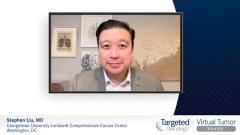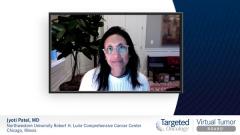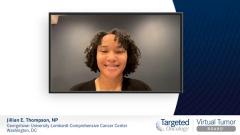
Case 2: Sequencing ALK TKIs in NSCLC
Moving on to discuss the second patient case of ALK+ NSCLC, expert panelists elucidate the sequencing ALK TKIs following progression on first-line therapy.
Episodes in this series

Transcript:
Stephen Liu, MD: Let’s go to our second case for the rest of this Virtual Tumor Board®. This is talking about treatment sequencing. Here we have a 53-year-old American woman of Welsh descent. She presents for follow-up care diagnosed with ALK-positive lung cancer last year. Initial imaging on the CT scan showed multiple nodules in both lungs, the largest [measuring] 3 cm. We saw enlarged lymph nodes, and a good performance status biopsy showed adenocarcinoma confined to the lungs [with a] EML4-ALK fusion and PD-L1 of 0%. This patient started with alectinib for 11 months. At 3 months we had a partial response. At 6 months [there was] nearly a complete response. But at a year we’re starting to see growth. It’s a little on the early side. Would you agree, Ross?
Ross Camidge, MD, PhD: Yes. If you’re expecting that the median PFS [progression-free survival] is close to 3 years, this hints at what the mechanisms of resistance might be, but we’ll go into that in a second.
Stephen Liu, MD: The CT scan showed progression. What’s the first step that we do here? Let’s talk about the role of rebiopsy. Jyoti, do we need to rebiopsy here, or should we just go?
Jyoti Patel, MD: I generally do a rebiopsy. I do blood and hopefully tissue. Remember, these patients will often progress only in the brain, so tissue can sometimes be a little more challenging. But if accessible, I’d do both.
Stephen Liu, MD: So blood, ctDNA [circulating tumor DNA], liquid biopsy, and a tissue biopsy. Jillian, [do you have a] similar approach?
Jillian E. Thompson, NP: Yes, same: tissue biopsy and liquid.
Stephen Liu, MD: Ross, you as well?
Ross Camidge, MD, PhD: Yes, we try to be led by the science if we can. Obviously, if the biopsy is difficult, you have to do a socket-and-see approach by trying a different ALK inhibitor. But as we’ll go on to discuss, not everybody has ALK-dependent resistance in that setting; therefore, changing to a different ALK inhibitor may do absolutely nothing.
Stephen Liu, MD: We’re talking about sort of different mechanisms of resistance, whether they’re on or off target. Fortunately, we have data to use some of these drugs in sequence. The initial data were done empirically. We think of ALTA-2, which looked at brigatinib in patients who had progressed on prior alectinib or ceritinib. We did see activity. Ross, you had mentioned this is sometimes a drug you use in the second-line setting after alectinib. Does your experience mirror what we’ve seen in the studies?
Ross Camidge, MD, PhD: As we look at all the studies in totality, we’re starting to see that the response rate isn’t 70% to 80%. For some drugs it might be 40%, which it is for lorlatinib. For brigatinib, after these other drugs it’s about 30%. What it’s telling us is that some patients progress and have on-target resistance through a mechanism, which is sensitive to 1 of these other ALK inhibitors. But the elephant in the room is that more than 50% of patients aren’t responding, and that’s probably because they have a second driver. Even though there’s no licensed drug there—there’s no drug rep telling you about doing these other things—that’s what all the data are telling us.
Stephen Liu, MD: Sometimes we do biopsy and other drivers looking for a histological transformation—a small cell squamous transformation. Is that something we’re concerned about in ALK, Jyoti?
Jyoti Patel, MD: Much less frequently. I’m looking for another molecular attractor or resistance mechanism.
Stephen Liu, MD: Ross, we now do these biopsies, but how often is it useful to do this [next-generation sequencing] testing after progressing on a first ALK TKI [tyrosine kinase inhibitor]?
Ross Camidge, MD, PhD: What you’re trying to figure out is when you do the biopsy. If you say, “I’m going to throw you on alectinib,” then you’re going to be right 40% of the time. But for a patient who pushes you to go on a next-generation ALK inhibitor on a trial that they have to pay out of pocket to travel for, I’d want to know if that was a good idea. Let’s say that 40% of the time you’re going to find an on-target mechanism resistance. Maybe you’re going to have a choice between brigatinib or lorlatinib, but you’ll have more choices rather than just whatever is in the pharmacy. But the second drivers are the emerging area. We know that MET amplification occurs in about 20% of patients in this setting, and you can add a MET inhibitor off-label. I’ve also seen, essentially anything else that can drive a cancer, can come in as a best supporting actor. I’ve seen BRAF, KRAS, and EGFR mutations, and all the rules we learned explode in this setting. These things aren’t mutually exclusive in the acquired-resistance setting.
Stephen Liu, MD: Having another biopsy is a [big] ask to the patient. It exposes risk, and it’s somewhat invasive. Jillian, do you find the patients are generally receptive to having this additional biopsy?
Jillian E. Thompson, NP: Typically they are. Most patients want to know specifically what’s going on because they want to get the most effective treatment. It’s useful to present that as an option.
Stephen Liu, MD: Jyoti, if someone is listening, how essential is that biopsy? Do you think that’s the standard of care right now?
Jyoti Patel, MD: It’s a standard of care. All of us would do our darndest to get 1 of these biopsies, but is it absolutely wrong to move on to lorlatinib or chemotherapy? No.
Ross Camidge, MD, PhD: I totally agree. But if you put somebody on lorlatinib and they don’t respond, they’re tipping their hand that they probably have a second driver or conceivably a compound mutation. Then I’d push for a biopsy if I hadn’t had 1.
Stephen Liu, MD: We know that biopsy is a lot easier to recommend than to do, even in studies where biopsy is the focus. If we look at the EGFR world, the ELIOS trial, which Zofia Piotrowska presented [at the European Society for Medical Oncology Congress], was a study where the whole point was to do biopsies of progression. On study, the rate of paired NGS biopsies was 40% or less. Even in ideal circumstances, it’s not always possible. It’s important to not feel bad if it’s not feasible to do. There are options.
Jyoti, you mentioned chemotherapy. It’s important. Ross, I often cite your own paper from years ago showing that chemotherapy is an effective option that isn’t considered all the time.
Ross Camidge, MD, PhD: In 2011, we had all these patients screening for ALKby FISH [fluorescence in situ hybridization] to go on a crizotinib study. We had all these positive [patients]. We’d go “Hey, you’re ALK positive.” They go, “But I’m doing fine.” They were on pemetrexed maintenance therapy, sometimes for years. That’s when the penny dropped. All the genes rearranged subtypes of lung cancer—ALK, ROS1, RET, maybe NTRK even though there’s never enough to study—have exaggerated sensitivity to pemetrexed.
Stephen Liu, MD: Chemotherapy is an important active agent that we don’t want to forget about.
Transcript edited for clarity.










































